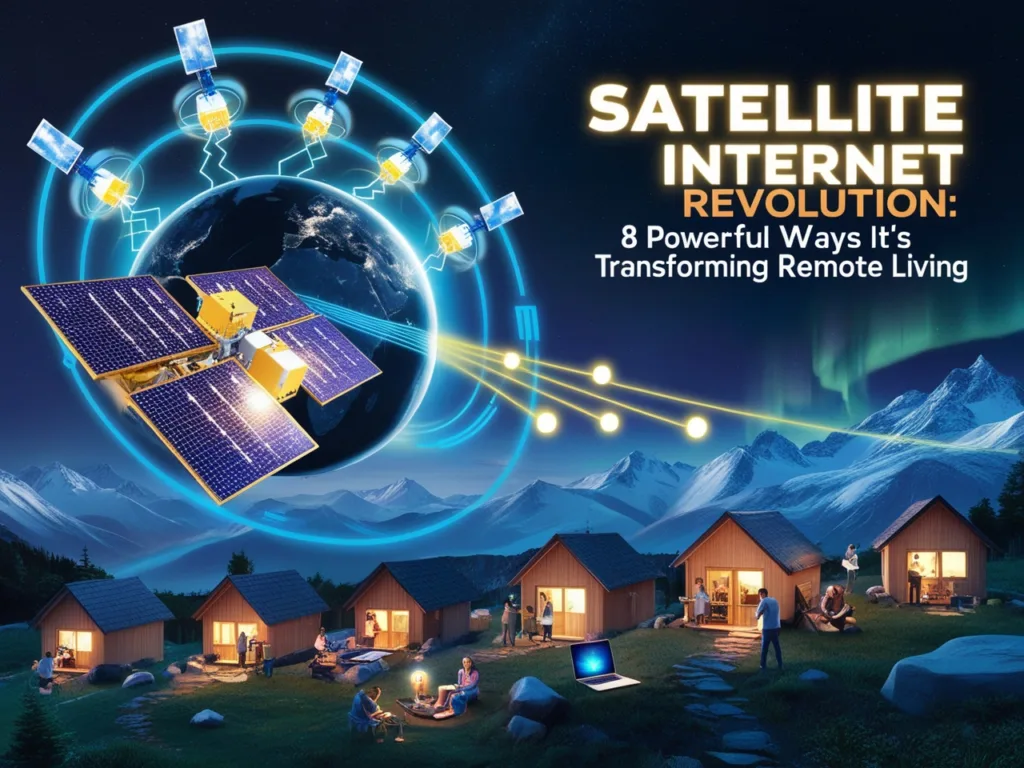Table of Contents

Introduction
🌍Picture in your mind a world where the most isolated regions of the planet are every bit as wired as downtowns. A world without geographical limiters hindering education, healthcare or employment? This isn’t a distant future — it’s the present as forged by the satellite internet revolution.
Thousands of remote and rural communities have suffered slow, unreliable or non-existent internet connectivity for too long. It is a digital divide that has been the great constraint on progress, the door to opportunity closed against millions. However, now an era of connectivity is upon us that is set to usher in a new form of life for the entirety of these populations. 🛰️💻
Satellite internet is a game-changer when it comes to enabling remote working, transforming rural education, improving healthcare provision in isolated communities and stimulating local economies allowing people to live and work from home. This technology is helping bridge ever-widening gaps, and open new doors. 8 Powerful Ways Of Doing It In this post. Prepare to learn not just how the age of satellite internet has tied the world together, but also how it’s transforming that connective tissue into a new shape. 🌟
The Future of Connectivity: Enhanced Solutions for Remote Areas
Satellite internet is revolutionizing connectivity in remote areas, offering unprecedented solutions to long-standing challenges. Let’s explore how this technology is bridging the digital divide, overcoming geographical barriers, and enabling high-speed internet access in even the most isolated locations.
Bridging the Digital Divide
Satellite internet is rapidly closing the gap between urban and rural connectivity:
- Global Coverage: Unlike traditional infrastructure, satellite networks can reach virtually any location on Earth.
- Affordable Access: Increasing competition is driving down costs, making high-speed internet more accessible to remote communities.
- Equal Opportunities: Improved connectivity enables remote areas to access the same digital resources as urban centers.
Overcoming Geographical Barriers
Satellite technology transcends physical obstacles that have historically limited internet access:
- Mountains, deserts, and oceans no longer pose insurmountable challenges
- Remote islands and isolated communities can now connect to the global network
- Areas prone to natural disasters can maintain communication links during emergencies
Enabling High-Speed Internet Access
Modern satellite internet offers speeds comparable to terrestrial broadband:
| Provider | Download Speed | Latency |
|---|---|---|
| Starlink | Up to 150 Mbps | 20-40ms |
| Project Kuiper | Projected 400 Mbps | TBD |
| Traditional Satellite | 25-100 Mbps | 500-600ms |
These advancements enable:
- Seamless video streaming and conferencing
- Cloud computing and remote work opportunities
- Online education and telemedicine services
- IoT applications for agriculture and environmental monitoring
As satellite technology continues to evolve, it promises to transform life in remote areas, bringing the benefits of the digital age to every corner of the globe. This connectivity revolution is not just about internet access; it’s about creating equal opportunities and fostering global inclusion.

Remote Revolution: Transforming Work for a Better Future
Supporting Digital Nomad Lifestyles
Satellite internet is revolutionizing the way digital nomads live and work. With reliable high-speed connections available in even the most remote areas, professionals can now embrace a truly location-independent lifestyle. This technology enables digital nomads to:
- Work from exotic locations without compromising productivity
- Explore new cultures while maintaining steady income
- Reduce living costs by choosing affordable destinations
Facilitating Virtual Collaboration and Meetings
The advent of satellite broadband has significantly improved virtual collaboration, making it possible for teams to work seamlessly across vast distances. This transformation is evident in:
| Aspect | Impact |
|---|---|
| Video Conferencing | Crystal-clear HD video calls in remote locations |
| File Sharing | Quick and reliable transfer of large files |
| Real-time Collaboration | Smooth operation of cloud-based tools and platforms |
Boosting Productivity with Reliable Internet
Satellite technology, particularly advancements from companies like SpaceX’s Starlink and Amazon’s Project Kuiper, is drastically improving internet speed and reliability in rural areas. This boost in connectivity directly translates to increased productivity for remote workers by:
- Eliminating frustrating connection dropouts
- Enabling faster download and upload speeds for resource-intensive tasks
- Providing consistent access to cloud-based productivity tools
Expanding Job Markets for Rural Residents
The satellite internet revolution is breaking down geographical barriers in the job market. Rural residents now have access to a global pool of employment opportunities, leading to:
- Increased economic diversity in rural communities
- Reduced urban migration as high-paying jobs become accessible remotely
- Enhanced skill development through online courses and training programs
With these advancements, the future of work is becoming increasingly decentralized, offering new possibilities for both employers and employees. As we move forward, let’s explore how this technology is not only transforming work but also revolutionizing education in remote areas.

Transforming Rural Education
Satellite internet is revolutionizing education in rural areas, bridging the digital divide and providing unprecedented access to learning resources. This technology is leveling the playing field for students in remote locations, offering them opportunities that were once limited to their urban counterparts.
Enabling Distance Learning Programs
Satellite internet has made distance learning a viable option for rural students. With high-speed connections, students can:
- Participate in live video classes
- Submit assignments online
- Collaborate with peers from different geographical locations
This connectivity ensures that rural students have access to a wider range of courses and specialized programs that may not be available locally.
Expanding Educational Resources
The advent of satellite internet has significantly expanded the pool of educational resources available to rural students. Here’s how:
- Access to digital libraries and research databases
- Availability of educational video content and documentaries
- Participation in virtual field trips and interactive learning experiences
| Traditional Rural Education | Satellite-Enabled Education |
|---|---|
| Limited textbooks | Vast online libraries |
| Local teacher expertise | Access to global experts |
| Fixed curriculum | Personalized learning paths |
Access to Online Learning Platforms
Satellite internet has opened the door to a multitude of online learning platforms, transforming the educational landscape in rural areas. Students can now:
- Enroll in Massive Open Online Courses (MOOCs) from prestigious universities
- Use adaptive learning software that tailors content to individual needs
- Participate in coding bootcamps and other skill-based online programs
These platforms provide students living in remote areas with a chance to learn and skill, dwell into different domains, focus on vocations which can lead into the world of digital economy.
And satellite technology like Starlink or Project Kuiper has ensured faster speeds, making for better quality of these learning experiences. This way, in the future with the integration of satellite internet in rural education, it will be possible to carry out a fairer and more accessible learning environment for all students regardless of where they are located.

Improving Healthcare in Isolated Communities
Now that we’ve explored the impact of satellite internet on education, let’s delve into how this technology is revolutionizing healthcare in remote areas. Satellite internet is bridging the gap between isolated communities and quality medical care, transforming the healthcare landscape in unprecedented ways.
Emergency Communication Systems
Satellite internet has become a lifeline for emergency communications in remote areas. With reliable connectivity, first responders can:
- Coordinate rescue operations more effectively
- Access real-time patient data during emergencies
- Communicate with medical experts for immediate guidance
This enhanced communication system significantly improves response times and outcomes in critical situations.
Access to Medical Information and Resources
Satellite internet provides healthcare professionals in isolated communities with:
- Up-to-date medical research
- Online training programs
- Digital medical libraries
This access to information empowers local healthcare providers to offer better care and stay current with the latest medical advancements.
| Benefits of Access | Impact on Healthcare |
|---|---|
| Continuous learning | Improved diagnosis and treatment |
| Access to specialists | Enhanced patient care |
| Resource sharing | Optimized healthcare delivery |
Telemedicine and Remote Consultations
Telemedicine has emerged as a game-changer for remote healthcare. Satellite internet enables:
- Video consultations with specialists
- Remote monitoring of patients with chronic conditions
- Virtual mental health support
These services reduce the need for long-distance travel, making healthcare more accessible and convenient for patients in isolated areas.
With satellite technology like Starlink improving speed and reliability, the quality of telemedicine services continues to enhance, bringing world-class healthcare to even the most remote corners of the world.

The Future of Farming: Enhancing Agricultural Practices for a Food-Secure and Sustainable World
Now that we’ve explored the impact of satellite internet on various aspects of remote living, let’s delve into how this technology is revolutionizing agriculture. Satellite internet is transforming farming practices, leading to increased productivity and sustainability in rural areas.
Precision Farming Techniques
Satellite internet enables farmers to implement precision farming techniques, optimizing crop yields and resource management. With access to high-speed internet, farmers can:
- Use GPS-guided tractors for precise planting and harvesting
- Employ drones for crop monitoring and targeted pesticide application
- Implement IoT devices for soil moisture and nutrient monitoring
| Traditional Farming | Precision Farming with Satellite Internet |
|---|---|
| Manual field surveys | Real-time satellite imagery analysis |
| Uniform irrigation | Targeted, water-efficient irrigation |
| Blanket pesticide application | Precise, need-based pesticide use |
Connecting with Agricultural Experts
Satellite internet bridges the gap between remote farmers and agricultural experts, facilitating knowledge exchange and problem-solving:
- Virtual consultations with agronomists
- Access to online agricultural forums and communities
- Participation in webinars and online training sessions
Real-Time Weather and Market Data
Access to up-to-date information is crucial for farmers to make informed decisions. Satellite internet provides:
- Accurate, localized weather forecasts for better crop management
- Real-time market prices to optimize selling strategies
- Alerts for potential pest outbreaks or extreme weather events
By leveraging satellite internet, farmers in remote areas can adopt modern agricultural practices, leading to increased food security and sustainable farming methods. This technology is not just transforming individual farms but is paving the way for a more resilient and productive global agricultural system.

Boosting Local Economies
Satellite internet is revolutionizing local economies in remote and rural areas, creating unprecedented opportunities for growth and development. Let’s explore how this technology is transforming these communities.
Improving Tourism through Better Connectivity
High-speed satellite internet is breathing new life into rural tourism. With reliable connectivity, remote destinations can now:
- Offer seamless online booking systems
- Provide real-time virtual tours
- Enable guests to stay connected during their visits
This improved connectivity enhances the overall tourist experience, attracting more visitors and boosting local economies.
| Tourism Benefits | Impact on Local Economy |
|---|---|
| Increased bookings | Higher revenue for accommodations |
| Enhanced visitor experience | Positive reviews and repeat visits |
| Expanded marketing reach | Attraction of international tourists |
Attracting Digital Entrepreneurs to Remote Areas
Satellite internet is breaking down geographical barriers, making it possible for digital entrepreneurs to set up shop in rural areas. This influx of talent and innovation brings:
- New job opportunities for locals
- Increased demand for local services
- Knowledge transfer and skill development
Remote areas are now becoming attractive hubs for startups and freelancers seeking a better work-life balance and lower costs of living.
E-commerce Opportunities for Rural Businesses
With reliable satellite internet, rural businesses can now tap into the global marketplace. This expansion into e-commerce offers:
- Access to a wider customer base
- Ability to showcase and sell local products internationally
- Reduced dependence on local foot traffic
Small rural businesses can now compete on a global scale, bringing in new revenue streams and contributing to the growth of local economies.
As we’ve seen, satellite internet is a game-changer for remote economies. Next, we’ll explore how this technology is strengthening community connections in these areas.

Strengthening Community Connections
Satellite internet is revolutionizing the way remote communities stay connected, fostering stronger bonds and breaking down barriers of isolation. Let’s explore how this technology is enhancing cultural exchange, improving access to information, and facilitating online social interactions.
Cultural Exchange Opportunities
Satellite internet opens up a world of cultural exchange for remote communities:
- Virtual museums and galleries
- Online language exchange programs
- International pen pal initiatives
- Live-streamed cultural events
These opportunities allow residents in remote areas to experience diverse cultures without leaving their homes, broadening their perspectives and fostering global understanding.
Access to News and Information
With satellite internet, staying informed becomes effortless for remote communities:
| Information Type | Benefits |
|---|---|
| Local News | Real-time updates on community events and issues |
| Global News | Broader understanding of world events and their impact |
| Weather Forecasts | Improved preparedness for extreme weather conditions |
| Emergency Alerts | Faster response to potential threats or disasters |
This enhanced access to information empowers residents to make informed decisions and actively participate in both local and global discussions.
Social Media and Online Community Platforms
Satellite technology enables remote communities to leverage social media and online platforms for connection:
- Facebook groups for local event planning and discussions
- Twitter for real-time updates and community announcements
- Instagram for sharing local culture and attractions
- LinkedIn for professional networking and job opportunities
- Online forums for sharing advice and problem-solving
These platforms help bridge the gap between isolated areas and the wider world, fostering a sense of belonging and reducing feelings of isolation.
As we’ve seen, satellite internet is a powerful tool for strengthening community connections in remote areas. Next, we’ll explore how this technology is contributing to environmental monitoring and conservation efforts.

Environmental Monitoring and Conservation
Satellite internet technology is revolutionizing environmental monitoring and conservation efforts in remote areas, providing crucial data and connectivity for various ecological initiatives. Let’s explore how this technology is making a significant impact on our planet’s health and sustainability.
A. Supporting Disaster Prevention and Response
Satellite internet plays a vital role in disaster prevention and response, especially in remote regions. By providing real-time data and communication capabilities, it enables:
- Early warning systems for natural disasters
- Rapid deployment of emergency resources
- Continuous monitoring of high-risk areas
| Disaster Type | Satellite Internet Application |
|---|---|
| Wildfires | Real-time fire detection and spread prediction |
| Hurricanes | Accurate tracking and evacuation planning |
| Earthquakes | Seismic activity monitoring and alert systems |
B. Facilitating Sustainable Resource Management
Wireless Space Connection enhances sustainable resource management practices by:
- Providing remote access to resource data
- Enabling real-time monitoring of resource usage
- Supporting decision-making with up-to-date information
This technology allows for more efficient management of forests, water resources, and other natural assets in remote areas.
C. Remote Sensing for Environmental Protection
Remote sensing capabilities are greatly improved with satellite internet, offering:
- High-resolution imagery of remote ecosystems
- Continuous monitoring of environmental changes
- Detection of illegal activities (e.g., deforestation, poaching)
These advancements help conservationists and researchers protect vulnerable habitats and species more effectively.
D. Real-Time Wildlife Tracking
Wireless Space Connection technology has revolutionized wildlife tracking by:
- Enabling GPS collar data transmission in real-time
- Facilitating remote monitoring of endangered species
- Supporting anti-poaching efforts through improved surveillance
This technology provides invaluable insights into animal behavior and migration patterns, contributing to more effective conservation strategies.
With these powerful applications, satellite internet is proving to be an indispensable tool in our efforts to protect and preserve the environment. Next, we’ll address some frequently asked questions about satellite internet and its impact on remote living.

Conclusion
Satellite Internet is changing the way people live in order to remote areas by providing unmatched connectivity and opportunity to those who may never have had it otherwise. Ranging from transforming work and education to improving healthcare and agricultural practices, this technology is narrowing the digital divide and making a more connected world. It is fostering local economic development, community cohesion and even supporting environmental conservation.
The age of connectivity It is obvious that satellite internet is now at the center of a new era, not just in terms of technology but also in terms of social and economic growth for these hard-to-reach areas. How Satellite Internet Works: For Remote Workers, Rural Students & Explorer Maintain a connection from anywhere in the world Whether you are trying to work from home, attend school at a rural location or exploring other parts of the world, satellite internet provides them with high-speed options. Adopt this transformative technology and join the remote living revolution that is defining our future.
FOR MORE SCIENCE BASED INTERESTING UPDATES & FOR LATEST …….

FAQ
What is satellite internet and how does it work?
Satellite internet is a type of broadband connection that uses satellites orbiting the Earth to transmit data. Here’s a simplified explanation of how it works:
- User sends a request through their satellite dish
- Signal travels to the satellite in orbit
- Satellite relays the signal to a ground station
- Ground station processes the request and sends data back
- Data follows the reverse path to reach the user
How does satellite internet compare to traditional broadband?
| Feature | Satellite Internet | Traditional Broadband |
|---|---|---|
| Availability | Global coverage | Limited to urban areas |
| Speed | Improving (up to 100+ Mbps) | Generally faster (up to 1 Gbps+) |
| Latency | Higher (20-600ms) | Lower (1-20ms) |
| Installation | Requires dish setup | Uses existing infrastructure |
| Weather impact | Can be affected by severe weather | Generally more stable |
Which companies are leading the satellite internet revolution?
Several companies are at the forefront of satellite internet technology:
- SpaceX’s Starlink
- Amazon’s Project Kuiper
- One Web
- HughesNet
- ViaSat
What are the speed expectations for satellite internet in remote areas?
Speed performance for satellite internet in remote areas has significantly improved:
- Download speeds: 50-150 Mbps
- Upload speeds: 10-20 Mbps
- Latency: 20-40ms (for low Earth orbit satellites)
Note that actual speeds may vary depending on factors such as location, weather conditions, and network congestion.
How is satellite technology improving rural education?
Satellite internet is transforming rural education by:
- Providing access to online learning resources
- Enabling virtual classrooms and distance learning
- Offering professional development opportunities for teachers
- Facilitating access to digital libraries and research materials
These improvements are helping to bridge the educational gap between urban and rural areas.
